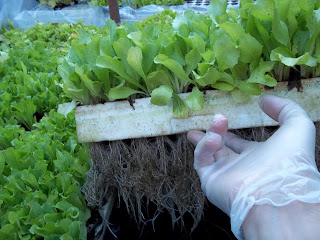
Photo via CCRES AQUAPONICS
The Chinampas of Mexico
Chinampa is a method of ancient Mesoamerican agriculture which used small, rectangle-shaped areas of fertile arable land to grow crops on the shallow lake beds in the Valley of Mexico.
Foto via Anthony Morgan and his blog at: bcr-8history.blogspot.com
Mexico City, a thriving metropolis of 20 million, is built on and around the ancient Aztec city of Tenochtitlan. Founded in 1325, this city was at its greatest a sophisticated and technologically-advanced city of 200,000 inhabitants nestled in the valley of Mexico and surrounded by a series of connected lakes.
The market district, Tlateloco was estimated by Spanish explorer Bernal Diaz del Castillo to be twice the size of Seville and bustling with over 60,000 shoppers and traders. The produce and goods for this market and several others in the city came mostly from the intricate and efficiently irrigated gardens created by the Aztecs in the shallow lakes surrounding the city. These gardens, called chinampas , were artificial island plots of 30 x 2.5-3 meters. These “floating gardens” produced 3 crops a year and grew at least a half to two-thirds of the food consumed by the 200,000 residents of Tenochtitlan.

Foto via Anthony Morgan and his blog at: bcr-8history.blogspot.com
The earliest fields that have been securely dated are from the Middle Postclassic period, 1150 – 1350 CE. Chinampas were used primarily in Lakes Xochimilco and Chalco near the springs that lined the south shore of those lakes. The Aztecs not only conducted military campaigns to obtain control over these regions but, according to some researchers, undertook significant state-led efforts to increase their extent.[4] Chinampa farms also ringed Tenochtitlán, the Aztec capital, which was considerably enlarged over time. Smaller-scale farms have also been identified near the island-city of Xaltocan and on the east side of Lake Texcoco. With the destruction of the dams and sluice gates during the Spanish conquest of Mexico, many chinampas fields were abandoned, although remnants are still in use today in what remains of Lake Xochimilco.
Among the crops grown on chinampas were maize, beans, squash, amaranth, tomatoes, chili peppers, and flowers.[5] It is estimated that food provided by chinampas made up one-half to two-thirds of the food consumed by the city of Tenochtitlán. Chinampas were fertilized using lake sediments as well as human excrement.
Among the crops grown on chinampas were maize, beans, squash, amaranth, tomatoes, chili peppers, and flowers.[5] It is estimated that food provided by chinampas made up one-half to two-thirds of the food consumed by the city of Tenochtitlán. Chinampas were fertilized using lake sediments as well as human excrement.
Irrigated by the surrounding lake water, the chinampas were fertilized by digging up the nutrient-rich mud from the bottom of the canals and also by using human waste from the city itself. In this way, Tenochtitlan was able to better fertilize its crops while treating its wastewater? creating a healthier living environment for all. Crops were easily transported to market along the many canals and lakes surrounding the chinampas. When the Spaniards arrived it did not take them long to dimantle the complex system and put in place traditional monocropping. Today, some chinampas survive in the Xochimilo area close to Mexico City. They are cared for in the traditional way and create both food and an opportunity for a healthy tourist industry. Mexico city is currently trying to create a waste-water treatment system incorporating the use of chinampas similar to the ones used by the Aztecs so long ago.

Foto via Wikipedia
More information on the chinampas of Mexico.
CCRES special thanks to Anthony Morgan and his blog at: bcr-8history.blogspot.com.
CCRES AQUAPONICS
part of
CROATIAN CENTER of RENEWABLE ENERGY SOURCES (CCRES)

0 komentar:
Posting Komentar